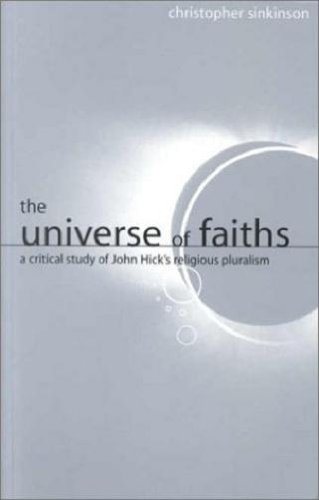THE UNIVERSE OF FAITHS: A CRITICAL STUDY OF JOHN HICK’S RELIGIOUS PLURALISM
Written by Christopher Sinkinson Reviewed By Matthew W. MasonSince the late 1960s, John Hick has been one of the most significant advocates of a pluralist view of the world’s religions. The Universe of Faiths considers his pluralism from the point of view of his epistemology, demonstrating that, although Hick’s theology has undergone radical revisions throughout his career, its foundation has remained fundamentally unaltered.
Sinkinson shows that Hick has a lot in common with the skeptical tradition in philosophy. More importantly, in rejecting propositional revelation, he views revelation as ‘the felt experience of divine reality’ (34). In response to this revelation, faith is ‘man’s awareness of God’, an interpretation of reality. As such, it is similar to all knowledge.
Hick believes that there are three levels of interpretation: natural, moral and religious. These three levels interpret reality with increasing degrees of uncertainty. Religious knowledge is necessarily vague, because of the need to maintain human freedom: were the Real to reveal itself clearly, it would tip the scales in favour of belief, and so be coercive, reducing human freedom not to believe.
Sinkinson acknowledges that Hick disavows any direct dept to Immanuel Kant, but shows that his epistemology is markedly similar to Kant’s. Kant posits a noumenon/phenomenon distinction, so that we can only know the phenomenon—sense data as interpreted by the mind—and not the noumenon, or thing-in-itself. Thus, objective reality—the realm beyond appearances—is unknowable. Hence although Hick is committed to realism in religious language we can never know what the Real is really like. Therefore, all religions are equally legitimate responses to experiences of the Real; we cannot adjudicate between them. However, as Sinkinson notes, it is hard know how the Real can be experienced in any way, as noumena can have no casual relationship on phenomena: Hick’s epistemology suffers from the same problems at that of Kant (78–82).
Hick’s view of religion is also close to Kant. At its heart, religion is concerned with moral transformation; doctrinal distinctions are secondary and need not get in the way of religious tolerance.
Sinkinson’s critique is telling: far from valuing religious diversity, Hick’s view impoverishes religions, downplaying their distinctive claims and imposing an enlightenment grid that flattens out any differences, and relativises their claims about the nature of reality.
This is the real strength of the book. Sinkinson succeeds in showing that, whilst Hick’s view appears to be marked by epistemic humility and a tolerance of diversity, this humility masks a breath-taking arrogance; there is one religious viewpoint that claims priority over all others: Hick’s. Other religions are judged and found wanting at the bar of his enlightenment epistemology. He claims a privileged access to the truth about religion that can be found nowhere else. Sinkinson’s analysis is devastating, demonstrating that Hick’s view of religious diversity is both totalising and bankrupt, replacing the God who graciously reveals himself with the human self that can know nothing truly.
Sinkinson’s exposition is clear, his analyses cogent and incisive. For those who have not read a lot of Hick it would have been helpful to have some more extensive quotations in addition to Sinkinson’s summarises of Hick’s views. Equally, in so short a work there is a lot of repetition, perhaps too much. However, these are minor quibbles.
Sinkinson concludes by proposing a better way of approaching the world’s religions, that allows each faith to present itself on its own terms, recognising disagreements, but tolerating diversity. This chapter is all too brief; one can only hope that Sinkinson will furnish us with a more detailed evangelical approach to thinking about the universe of faiths.
Matthew W. Mason
Manchester







